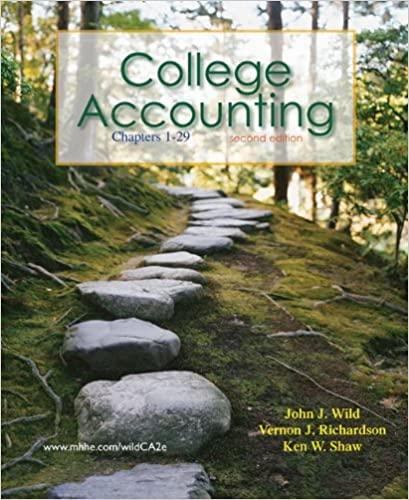Question
Question 24: Miller Toy Company manufactures a plastic swimming pool at its Westwood Plant. The plant has been experiencing problems as shown by its June
| Question 24: Miller Toy Company manufactures a plastic swimming pool at its Westwood Plant. The plant has been experiencing problems as shown by its June contribution format income statement below: |
| Budgeted | Actual | |||
| Sales (7,000 pools) | $ | 265,000 | $ | 265,000 |
| Variable expenses: | ||||
| Variable cost of goods sold* | 79,240 | 97,525 | ||
| Variable selling expenses | 19,000 | 19,000 | ||
| Total variable expenses | 98,240 | 116,525 | ||
| Contribution margin | 166,760 | 148,475 | ||
| Fixed expenses: | ||||
| Manufacturing overhead | 67,000 | 67,000 | ||
| Selling and administrative | 85,000 | 85,000 | ||
| Total fixed expenses | 152,000 | 152,000 | ||
| Net operating income (loss) | $ | 14,760 | $ | (3,525) |
| *Contains direct materials, direct labor, and variable manufacturing overhead. |
| Janet Dunn, who has just been appointed general manager of the Westwood Plant, has been given instructions to get things under control. Upon reviewing the plants income statement, Ms. Dunn has concluded that the major problem lies in the variable cost of goods sold. She has been provided with the following standard cost per swimming pool: |
| Standard Quantity or Hours | Standard Price or Rate | Standard Cost | |||
| Direct materials | 3.5 pounds | $ | 2.10 per pound | $ | 7.35 |
| Direct labor | 0.4 hours | $ | 7.60 per hour | 3.04 | |
| Variable manufacturing overhead | 0.3 hours* | $ | 3.10 per hour | 0.93 | |
| Total standard cost | $ | 11.32 | |||
| *Based on machine-hours. |
| During June the plant produced 7,000 pools and incurred the following costs: |
| a. | Purchased 29,500 pounds of materials at a cost of $2.55 per pound. |
| b. | Used 24,300 pounds of materials in production. (Finished goods and work in process inventories are insignificant and can be ignored.) |
| c. | Worked 3,400 direct labor-hours at a cost of $7.30 per hour. |
| d. | Incurred variable manufacturing overhead cost totaling $8,400 for the month. A total of 2,400 machine-hours was recorded. |
| It is the companys policy to close all variances to cost of goods sold on a monthly basis. |
| Required: |
| 1. | Compute the following variances for June: |
| a. | Materials price and quantity variances. (Indicate the effect of each variance by selecting "F" for favorable, "U" for unfavorable, and "None" for no effect (i.e., zero variance).) |
| b. | Labor rate and efficiency variances. (Indicate the effect of each variance by selecting "F" for favorable, "U" for unfavorable, and "None" for no effect (i.e., zero variance).) |
| c. | Variable overhead rate and efficiency variances. (Do not round your intermediate calculations. Indicate the effect of each variance by selecting "F" for favorable, "U" for unfavorable, and "None" for no effect (i.e., zero variance).) |
| 2. | Summarize the variances that you computed in (1) above by showing the net overall favorable or unfavorable variance for the month. (Input all values as positive amounts. Indicate the effect of each variance by selecting "F" for favorable, "U" for unfavorable, and "None" for no effect (i.e., zero variance).) |
| 3. | Pick out the two most significant variances that you computed in (1) above. (You may select more than one answer. Single click the box with a check mark for correct answers and double click to empty the box for the wrong answers.) Question 25:
| ||||||||||||||||||||||||||||||||||||||||||||||||||||||||||||||||||||||||||||||||||||||||||||||||||||||||||||||||||||||||||||||||||||||||||||||||||||||||||||||||||||||||||||||||||||||||||||||||||||||||||||||||||||||||||||||||||||||||||||||||||||||||||||||||||||||||||||||||||||||||||||||||||||||||||||||||||||||||||||||||||||||||||||||||||||||||||||||||||||||||||||||||||||||||||||||||||||
Step by Step Solution
There are 3 Steps involved in it
Step: 1

Get Instant Access to Expert-Tailored Solutions
See step-by-step solutions with expert insights and AI powered tools for academic success
Step: 2

Step: 3

Ace Your Homework with AI
Get the answers you need in no time with our AI-driven, step-by-step assistance
Get Started


